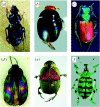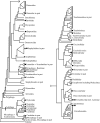Gold bugs and beyond: a review of iridescence and structural colour mechanisms in beetles (Coleoptera)
- PMID: 18957361
- PMCID: PMC2586663
- DOI: 10.1098/rsif.2008.0354.focus
Gold bugs and beyond: a review of iridescence and structural colour mechanisms in beetles (Coleoptera)
Abstract
Members of the order Coleoptera are sometimes referred to as 'living jewels', in allusion to the strikingly diverse array of iridescence mechanisms and optical effects that have arisen in beetles. A number of novel and sophisticated reflectance mechanisms have been discovered in recent years, including three-dimensional photonic crystals and quasi-ordered coherent scattering arrays. However, the literature on beetle structural coloration is often redundant and lacks synthesis, with little interchange between the entomological and optical research communities. Here, an overview is provided for all iridescence mechanisms observed in Coleoptera. Types of iridescence are illustrated and classified into three mechanistic groups: multilayer reflectors, three-dimensional photonic crystals and diffraction gratings. Taxonomic and phylogenetic distributions are provided, along with discussion of the putative functions and evolutionary pathways by which iridescence has repeatedly arisen in beetles.
Figures











References
-
- Acorn J. Mimetic tiger beetles and the puzzle of Cicindelid coloration (Coleoptera: Cicindelidae) Coleopterists Bull. 1988;42:28–33.
-
- Acorn J. The historical development of geographic color variation among dune Cicindela in Western Canada (Coleoptera: Cicindelidae) In: Noonan G.R., Ball G.E., Stork N.E., editors. The biogeography of ground beetles of mountains and islands. Intercept; Andover, UK: 1992. pp. 217–233.
-
- Aguiar A.P. An accurate procedure to describe colors in taxonomic works, with an example from Ichneumonidae (Hymenoptera) Zootaxa. 2005;1008:31–38.
-
- Alcock J. Courtship and mating in Hippomelas planicosta (Coleoptera: Buprestidae) Coleopterists Bull. 1976;30:343–348.
Publication types
MeSH terms
LinkOut - more resources
Full Text Sources
Other Literature Sources
